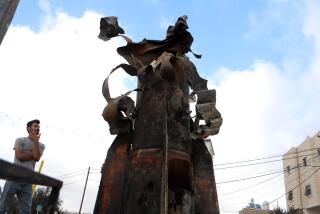Shakier Fingers on the Nuclear Buttons
- Share via
Ever since the nuclear genie escaped from the bottle in 1945, we have been preoccupied with preventing this destructive power from being used. The solutions we have come up with can be boiled down to two.
The first is deterrence: You prevent the use of nuclear weapons against you by having enough of them yourself so that, even if the opponent attacks, you retain enough of them intact to retaliate with.
Theorists of deterrence didn’t necessarily envisage that this dire scenario would occur. Their logic was that if each side knew the other had enough survivable weapons, neither would attack: Peace would flow from the balance of terror.
Deterrence has been roundly criticized, from the left and the right, but it has worked. No matter how deep the hatred between the Soviet Union and the United States, the Soviet Union and China, China and the U.S. or India and Pakistan, none of these pairs has been involved in a nuclear war. We’ve had nuclear weapons for over half a century now, so that’s not a bad record -- indeed, it’s miraculous.
The second response to the nuclear menace has been nonproliferation policies. These are based on the assumption that if the number of countries with nuclear weapons increases, so will the statistical probability of the weapons being used; it’s not unlike the reasoning of gun-control advocates.
But here too we’ve been remarkably successful. The know-how for building nuclear weapons has become widespread. Yet after more than 50 years, only a handful of states have them: the five permanent members of the U.N. Security Council plus India, Pakistan, Israel and, apparently, North Korea.
That may be too high a number, but it could have been -- and by all rights should have been -- a lot higher.
The 1968 Nuclear Nonproliferation Treaty is largely what has kept the nuclear club small. Under the treaty, nations that possess nuclear weapons promise not to transfer them to those that don’t, and those without such weapons promise not to get or build them and agree to have their energy-producing nuclear reactors subjected to inspections by the International Atomic Energy Agency.
Now, however, we face a totally different problem, and it can’t be solved with the old standbys of deterrence and nonproliferation. This new situation could be called “nuclear fragmentation” -- the sudden breakup because of civil war or revolution of countries possessing nuclear weapons. The specter of lots of nuclear weapons that are unaccounted for, that are poorly protected and that could therefore be stolen by nasty groups or that could be fired accidentally or willfully because anarchy destroys chains of command was the stuff of sci-fi thrillers. But sometimes life imitates art, and unfortunately that has become true of nuclear weapons. What was once imagined is now real.
Our first experience with the fragmentation problem was the unexpected collapse of the Soviet Union in 1991.
The demise of a totalitarian system was a good thing, but the dissolution of a union with tens of thousands of nuclear weapons was a not-so-good thing. We’re still coping with the consequences. Now, poverty-stricken Russia’s nuclear installations are often guarded by demoralized and poorly paid staff. Worries abound that organized crime rings and terrorists will steal Russia’s nuclear weapons or fissile materials. European police have intercepted smugglers sneaking nuclear materials from the former Soviet Union more than once.
Yet the Soviet Union is not a unique case of the fragmentation problem, which has become worse. That’s because there are several countries now that either have nuclear weapons or are trying to build them and that are at risk of breaking apart, including Pakistan, North Korea and Iran.
Pakistan has experienced upheaval for most of its existence, and Islamic fundamentalism has sunk deep roots in Pakistan’s body politic in the last two decades.
North Korea has recently stated that it has nuclear weapons. With the North Korean economy near implosion, its people starving and Pyongyang’s old benefactors, China and Russia, getting tired of carrying it, is it fantasy to imagine a North Korean collapse?
Iran doesn’t have nuclear weapons yet, but there’s a danger that it could get them thanks to Russian-built nuclear reactors. And change is in the wind. The rule of the ayatollahs has proven repressive, and Iranians, especially younger ones, are sick of it.
A revolution in Iran would not be a bad thing; a revolution in a nuclear Iran would be a much different story.
The bottom line is that our current tools to deal with nuclear threats -- deterrence and nonproliferation -- are inadequate to cope with the new problem of nuclear fragmentation. We must start thinking creatively about this new nuclear danger -- and soon -- if we want appropriate solutions.
More to Read
Sign up for Essential California
The most important California stories and recommendations in your inbox every morning.
You may occasionally receive promotional content from the Los Angeles Times.










